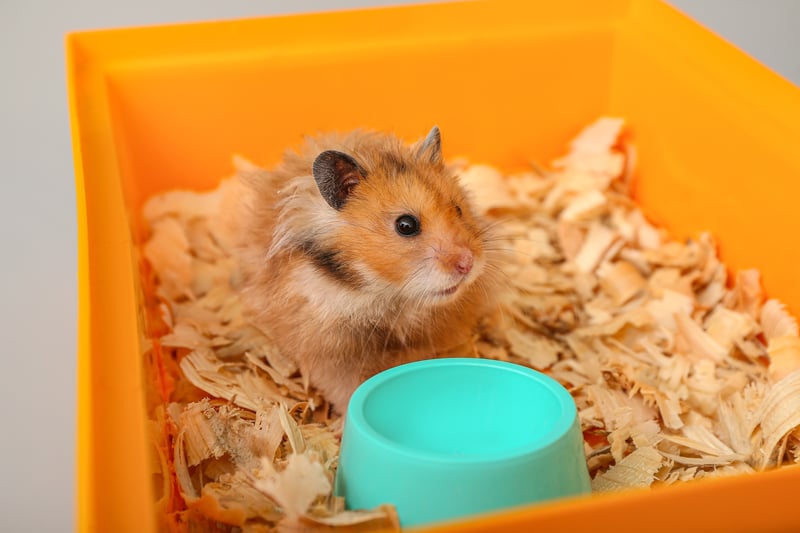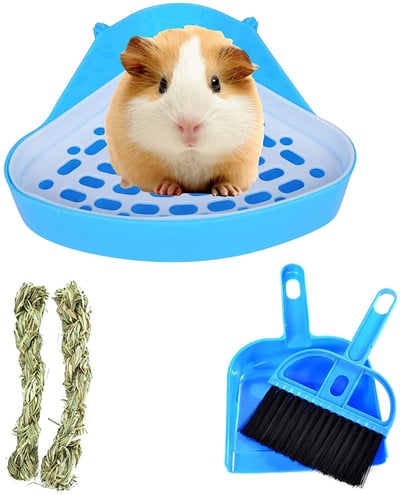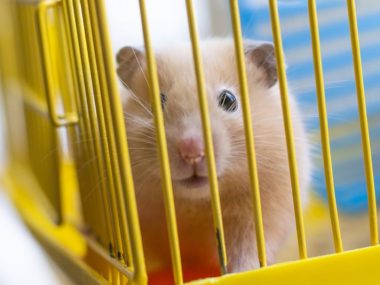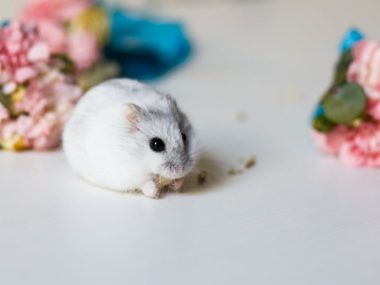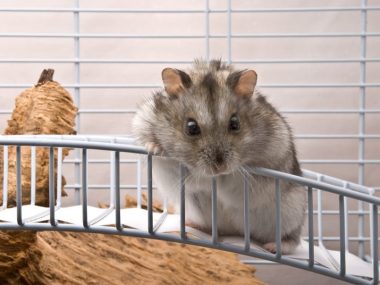Hamsters make great pets for people of all ages. They are small, relatively easy to care for, and entertaining to watch. The only downside to owning a hamster is that they can be challenging to potty train.
Here are four ways to potty train your hamster:
- Use a triangle potty.
- Fill corners with things your hamster can’t move.
- Reduce the bed size.
- Use a pop-a-scoop.
I provide more details on each of these strategies below. I will also cover some of the most asked questions about hamster potty training.
Disclosure: We may earn commissions for purchases made through links in this post.
Table of Contents
1. Use a Triangle Potty
One of the easiest ways to train your hamster is to use a triangle potty. A triangle potty is a small, triangular-shaped container that can fit on one corner. The potty can be placed in an area where the hamster has easy access, but it’s also big enough so that they won’t move it.
Here is an example of triangle potty available on Amazon:
Check the price of this triangle potty on Amazon.
You want to fill the potty with sand, litter pearls, or some other type of absorbent material. You’ll want to keep this area as clean as possible—otherwise, you might have an odorous hamster on your hands.
The trick is to clean and disinfect where your hamster potties and put a small part of the soiled material in the toilet area. This will send a strong signal to your hamster about where they should potty.
After that, be patient with your hamster and remember to clean the potty often. Hamsters are clean creatures, and they will change their potty spot if it is too filthy.
2. Fill Corners With Things Your Hamster Can’t Move
So you have set up a potty in one corner of the cage, but your hamster is still having trouble getting the idea. One way to help them along is to fill all of the other corners with things the hamster can’t move. This could be a pile of hay, a small toy, or another object.
The idea is to make the potty the only accessible corner in the cage. This way, they will quickly learn that this is the place where they should do their needs.
Keep in mind that you will still need to clean any other areas where the hamster goes potty. This will help reduce confusion and make it easier for your hamster to learn where they should go.
3. Reduce the Bed Size
Another way to potty train your hamster is to reduce its bed size. Hamsters love to have a lot of space to explore and play in, but when you are potty training them, it will help to reduce the size of their bed.
You can do this by moving their bed to a different part of the cage or by simply putting a smaller bed in their cage. The idea is to make it difficult for the hamster to do their business in the sleeping corner. This helps avoid health issues that can be caused by improper potty training.
Once the hamster has learned to use the potty, you can then increase the size of their bed again.
4. Using a Pop-a-scoop
Sometimes, the hamster may be peeing in the potty but pooping in other areas of the cage. This can be frustrating—it means you have to clean more than just the potty.
Here’s the thing: Your hamster has little control of where they poop. It is normal to find poop in the sand, on the bed, or even on the toys.
The best way to deal with this is to use a pop-a-scoop. It has a long handle and a small scoop with a sieve on one end. This sieve allows you to pick up the poop, leaving the clean sand behind.
Is It Easy To Potty Train a Hamster?
Potty training your hamster can be easy or very frustrating, depending on the hamster and how much effort you put into it. You can do everything right, but your hamster may still not get the idea.
Here’s a YouTube video on how to potty train your hamster:
If you delay cleaning the potty, so the hamster goes back to peeing and pooping all over the place. You want to be patient with your hamster and keep trying different strategies until you find one that works. In the end, it is worth it to have a well potty-trained hamster.
Will a Hamster Use a Litter Box?
A hamster will use a litter box. This is the most common way to potty train a hamster. The key is to get them used to the litter box at a young age. Some hamsters may take a little longer to get the idea, but most will eventually use the potty.
The best way to start is by putting the litter box in their cage and then placing some of their poop in it. This will help them get an idea of what it is for.
What Can I Use for a Hamster Litter?
Use dust-free, unscented litter for a hamster litter box. Because hamsters are sensitive to smells, they may not use the litter box if it smells weird.
Some good options for a hamster litter box are absorbent paper pellets, wood shavings (avoid cedar and pine shavings), and litter pearls. You can also use recycled paper products, such as those made from recycled office paper or shredded newspaper.

Just avoid using litter that contains corn, wheat, or any other type of grain. These can be harmful to the hamster if they eat them.
Why Do Hamsters Pee Out of the Cage?
Hamsters pee out of their cage because they’re not used to the litter box, their litter box isn’t clean, or there’s something they don’t like about their living situation.
There are a few reasons why a hamster may pee out of the cage:
- They’re not used to the litter box. It may be that they still haven’t gotten used to the litter box yet and are still trying to go in the cage. This is a normal part of the potty training process.
- The litter box is not clean. You need to clean the litter box regularly to encourage the hamster to use it.
- Your hamster doesn’t like their home. Pooping out of the cage may be a way to tell you that they’re not happy with their current living situation. If this is the case, you may need to re-evaluate your hamster’s home and make some changes.
Conclusion
It’s completely possible to potty train a hamster, but it may take some effort and patience on your part. Just be sure to use the right strategies and remain consistent, and your hamster will be using the potty like a pro in no time!
